Conquering the 2024 Cicada Invasion: Fly Fishing Strategies & Patterns

As the warmth of summer spreads across the United States, anglers eagerly anticipate one of nature's most remarkable events: the cicada hatch. This rare occurrence, which happens every 13 to 17 years, brings millions of cicadas to the surface, creating a feeding frenzy for fish. This year, the excitement is even greater, as this spring and summer will mark the largest emergence of periodical cicadas in more than 220 years. Two different broods are set to emerge simultaneously in certain corners of the country, resulting in a massive influx of large, edible insects. For anglers in these areas, this could lead to some of the hottest surface fishing in recent memory.
From around mid-May through June, billions of these chubby bugs will be singing in trees from Georgia to Pennsylvania to Illinois. They don’t belong in the water, but many will end up there anyway, and fish will respond just as you would expect.
Fly fishing during a cicada hatch can be exceptionally rewarding, but it requires the right patterns and techniques. In this month's fly of the month post, we'll explore the cicada fly pattern, various ways to fish with it, and a handful of other cicada-mimicking patterns, detailing when and how to use them for successful fly fishing. Understanding how to effectively imitate these cicadas and present them to fish can make the difference between a good day on the water and an unforgettable one.
Understanding the Cicada Fly Pattern
The cicada fly pattern is designed to mimic the appearance and behavior of cicadas. These insects are large, noisy, and often fall clumsily onto the water, making them easy targets for fish. This pattern features a bulky, foam body with realistic legs and wings, providing excellent buoyancy and a lifelike profile. Bright colors (typically featuring shades of black, brown, and orange) and a distinctive shape make it an irresistible target for opportunistic trout and bass. Effective in both streams and still waters, particularly near banks and overhanging vegetation, the Cicada should be fished dry on the surface, using a dead drift to mimic a struggling cicada.
Fishing Techniques for Cicada Patterns
- Surface Fishing: Cicadas are terrestrial insects, so they often land on the water's surface. Cast your cicada fly near overhanging trees or bushes where cicadas are likely to fall. Let it sit motionless to mimic a struggling cicada.
- Skittering: Gently twitch your rod tip to create small movements on the water, imitating the erratic behavior of a cicada trying to escape.
- Dead Drift: Allow your fly to drift naturally with the current. This technique works well in slower water where fish have more time to inspect their prey.
- Sight Fishing: Look for rising fish and target them specifically. Cast your fly ahead of their path and let it drift into their feeding zone.
You need a heavier leader than you use for mayfly patterns, but otherwise, fishing cicada patterns is pretty much the same as your beetles, hoppers, and ants. If you’re in an area with a heavy hatch and, importantly, trees near the water, you stand a good chance of having an exciting double brood emergence experience.
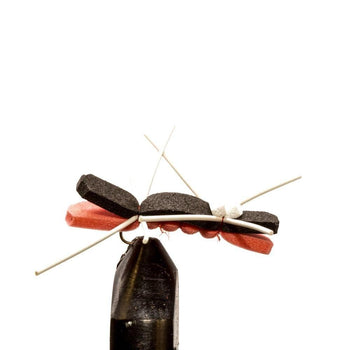 |
 |
 |
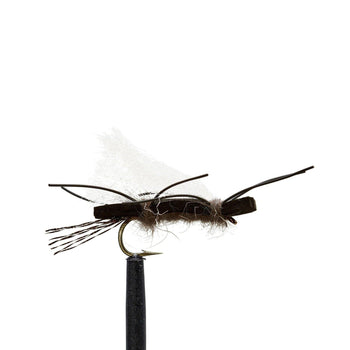 |
| Chernobyl Ant Red | Black/Red (Elvira) Chubby Chernobyl | Royal Chubby Chernobyl | Black (Vader) Chubby Chernobyl |
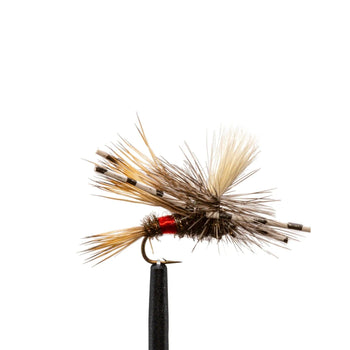 |
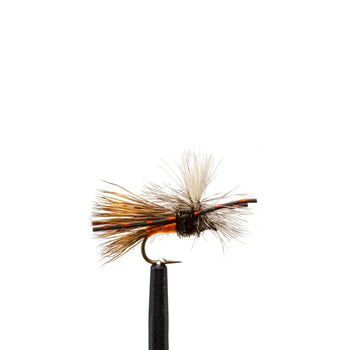 |
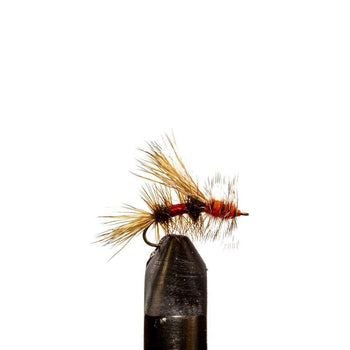 |
 |
| Royal Madam X | Fire Orange Madam X | Royal Stimulator | Tarantula Red |
Cicada-Mimicking Patterns
Chernobyl Ant Red: This fly has a high-floating foam body with rubber legs, designed to mimic the size and shape of a cicada. Use it during the peak of the hatch when cicadas are most active. Fish it on the surface near banks and overhanging vegetation, using a dead drift or slight twitch to attract attention.
Black/Red (Elvira) Chubby Chernobyl: A vibrant pattern with a dual-color scheme and a buoyant foam body, perfect for imitating cicadas. Ideal for murky water or low light conditions where visibility is limited. Cast near structure and allow it to sit or slowly twitch to mimic a struggling insect.
Royal Chubby Chernobyl: Featuring royal blue and red colors, this pattern is both attractive and effective. Use in clear water on sunny days when cicadas are most visible to fish. Fish on the surface with a dead drift or slight twitches.
Black (Vader) Chubby Chernobyl: A dark, stealthy pattern that blends well with shadowed water. Best used in shaded areas or during early morning and late evening. Use a dead drift or gentle skittering action.
Royal Madam X: A versatile fly with a flashy royal blue body and rubber legs, perfect for mimicking cicadas. Use during peak hatch periods and in clear water conditions. Cast near banks and let it drift naturally or with slight twitches.
Fire Orange Madam X: A bright, attention-grabbing pattern with an orange body and realistic profile. Use in stained or turbulent water where visibility is reduced. Fish on the surface with a dead drift or gentle twitching motion.
Royal Stimulator: A high-floating, buoyant fly with a royal blue body and hackle, great for mimicking large terrestrials. Effective throughout the hatch, especially in faster water. Dead drift in riffles or skitter across the surface.
Tarantula Red: A bulky, spider-like pattern with a red body and rubber legs, ideal for imitating cicadas. Use during the peak of the hatch in areas with heavy cover. Cast near structure and allow it to sit or use slight twitches to simulate movement.
When and Where Do Cicadas Come Out in 2024?
Cicadas begin to emerge from the ground when the soil temps hit 64 degrees. This year, the two cicada broods are expected to emerge starting in mid-May and ending in late June. If the weather is consistently warm and dry, the cicadas will finish mating sooner, which would mean a shorter season. Though cicadas emerge nearly every year in one- to 17-year life cycles, 2024 will mark the first time since 1803 that both a 13-year cicada hatch and a 17-year cicada hatch will occur at the same time. Just like with the Brood X hatch of 2021, these bugs will emerge from their subterranean homes all across the Central and Southern US from early May to June, or as soon as the temps below the ground have reached roughly 60 degrees.

Expect cicadas in the following states:
- Arkansas: White River, Bull Shoals Lake, Little Red River
- Missouri: Lake Taneycomo, Mississippi River, Missouri River, Lake of the Ozarks
- Georgia: Chattahoochee River, Lake Lanier, Savannah River, Carters Lake
- North Carolina: Nantahala Wilderness
- South Carolina: Lake Keowee
- Tennessee: Lake Barkley, Cumberland River, Kentucky Lake, Hiwassee River
- Illinois: Carlyle Lake, Wabash River, Lake Shelbyville, Grass Lake, Coffeen Lake
- Kentucky: Ohio River, Tennessee River
Fly fishing during the cicada hatch can be an exhilarating experience, with the potential for landing trophy-sized fish. By understanding the cicada fly pattern and employing the right techniques, you can maximize your chances of success. Experiment with different cicada-mimicking patterns and adjust your approach based on water conditions and fish behavior. With patience and practice, you'll be well-prepared to take full advantage of this extraordinary natural event. Happy fishing!








